Housing Honey Bees
Ruth O’Neill, Research Associate
Wanner Crop Entomology Lab, Plant Sciences and Plant Pathology
Honey bees require snug dry housing that is insulated from weather extremes, protected from predators, and provided with plenty of room for rearing brood and storing honey.
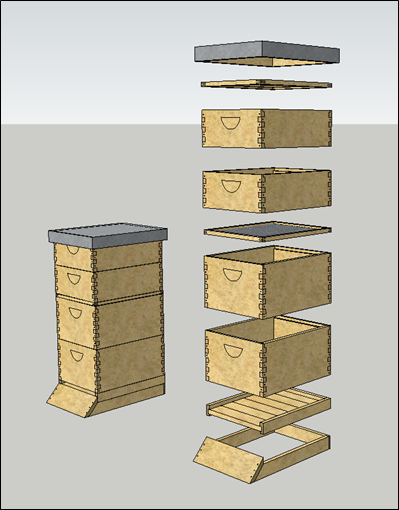 Most beekeepers, whether they are commercial producers or hobbyists, house their bees
in a “Langstroth hive”. Many bee supply businesses carry them as kits, usually costing
around $120.00 for basic components, not including shipping. Other hive styles can
be made from kits or DIY instructions available on the web or in some beekeeping books.
Some of these alternative set-ups are shown at the end of this page.
Most beekeepers, whether they are commercial producers or hobbyists, house their bees
in a “Langstroth hive”. Many bee supply businesses carry them as kits, usually costing
around $120.00 for basic components, not including shipping. Other hive styles can
be made from kits or DIY instructions available on the web or in some beekeeping books.
Some of these alternative set-ups are shown at the end of this page.
Langstroth hive:
The figure to the right shows a standard ten-frame Langstroth hive with the most basic hive components. Langstroth hive components are stacked vertically. No fasteners are required to join the components to one another because the bees fasten the seams together with propolis, a sealant made from a mixture of plant resins (from various sources) mixed with beeswax. However, a strap can be helpful to protect the hive from being knocked over by wind or large animals.
From bottom to top, the components shown in the top right figure are discussed below:
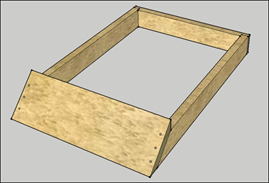 Hive stand: The function of the hive stand is to raise the hive off the ground, usually
two to twelve inches, to keep the colony dry. You can buy hive stands (shown), but
you can also improvise with whatever you have on hand. For example, concrete blocks,
scrap wood, or wood pallets work well. Situate the hive stand so that the hive tilts
slightly forward, to prevent moisture from collecting on the floor.
Hive stand: The function of the hive stand is to raise the hive off the ground, usually
two to twelve inches, to keep the colony dry. You can buy hive stands (shown), but
you can also improvise with whatever you have on hand. For example, concrete blocks,
scrap wood, or wood pallets work well. Situate the hive stand so that the hive tilts
slightly forward, to prevent moisture from collecting on the floor.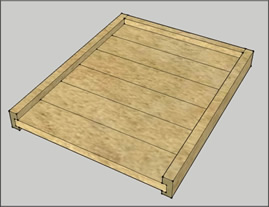 Bottom board: This is the floor of the hive. Three sides are raised about ¼” so
that when the main brood box is in place above the hive entrance is formed. Traditional
bottom boards are solid wood, but you can also buy screened bottom boards. Some bottom
boards have a removable solid tray fitted into a screened bottom board, giving the
beekeeper the ability to clean the floor of the hive out, place sticky pest traps
inside, or leave the drawer out during the summer to expose the screened floor.
Bottom board: This is the floor of the hive. Three sides are raised about ¼” so
that when the main brood box is in place above the hive entrance is formed. Traditional
bottom boards are solid wood, but you can also buy screened bottom boards. Some bottom
boards have a removable solid tray fitted into a screened bottom board, giving the
beekeeper the ability to clean the floor of the hive out, place sticky pest traps
inside, or leave the drawer out during the summer to expose the screened floor.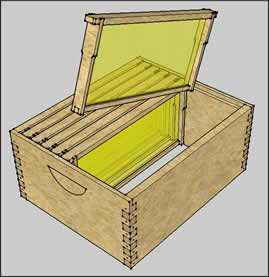 Brood boxes: These chambers house the queen and the developing bee brood. Each box
holds ten “deep frames” (six shown here), and each frame holds a sheet of “foundation”,
traditionally made of beeswax supported by fine wires. Foundation is stamped with
hexagonal imprints that guide bees in building comb. Most of the brood is clustered
in the center frames, with nectar, pollen, and honey stored in peripheral cells.
When bee packages are first introduced to an empty hive, one brood box is used. The
second brood box (also filled with frames) is added several weeks later, to give the
colony room to expand as summer progresses.
Brood boxes: These chambers house the queen and the developing bee brood. Each box
holds ten “deep frames” (six shown here), and each frame holds a sheet of “foundation”,
traditionally made of beeswax supported by fine wires. Foundation is stamped with
hexagonal imprints that guide bees in building comb. Most of the brood is clustered
in the center frames, with nectar, pollen, and honey stored in peripheral cells.
When bee packages are first introduced to an empty hive, one brood box is used. The
second brood box (also filled with frames) is added several weeks later, to give the
colony room to expand as summer progresses.  Queen excluder: This component keeps the queen from laying eggs in the honey supers
that will be placed above it. The gaps between the metal bars are five millimeters
wide, too narrow for the queen’s abdomen to fit through. Workers slip through the
bars and fill the empty cells with clean honey.
Queen excluder: This component keeps the queen from laying eggs in the honey supers
that will be placed above it. The gaps between the metal bars are five millimeters
wide, too narrow for the queen’s abdomen to fit through. Workers slip through the
bars and fill the empty cells with clean honey. Honey supers: Like the brood boxes, each honey super holds ten frames. Honey supers
are identical to brood boxes except that they are shorter. The smaller size makes
them easier to lift when they are full of honey. The super shown here is a “medium
super”, which when full can weigh 50 pounds. Even shorter “shallow supers” are also
available. Multiple supers can be added as needed during the summer to give bees more
room to store honey.
Honey supers: Like the brood boxes, each honey super holds ten frames. Honey supers
are identical to brood boxes except that they are shorter. The smaller size makes
them easier to lift when they are full of honey. The super shown here is a “medium
super”, which when full can weigh 50 pounds. Even shorter “shallow supers” are also
available. Multiple supers can be added as needed during the summer to give bees more
room to store honey. Inner cover: This is a sheet of framed Masonite with a slot in the middle that fits
certain types of syrup feeders. The inner cover provides extra insulation and moisture
protection in cold weather. It also keeps the bees from gluing down the telescoping
outer cover with propolis. Otherwise, the awkward overhang on the outer cover would
make it very difficult to pry off.
Inner cover: This is a sheet of framed Masonite with a slot in the middle that fits
certain types of syrup feeders. The inner cover provides extra insulation and moisture
protection in cold weather. It also keeps the bees from gluing down the telescoping
outer cover with propolis. Otherwise, the awkward overhang on the outer cover would
make it very difficult to pry off. 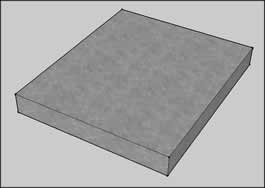 Telescoping cover: This top cover is a box with short overhanging sides that provides
weather protection. It is covered with galvanized sheet metal for moisture-proofing.
Telescoping cover: This top cover is a box with short overhanging sides that provides
weather protection. It is covered with galvanized sheet metal for moisture-proofing.
Some other hive styles:
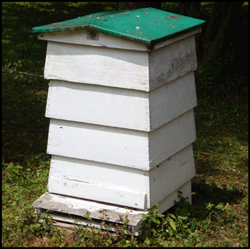 WBC hives have internal boxes covered with an external housing. The double-walled construction
offers insulation from temperature extremes.
WBC hives have internal boxes covered with an external housing. The double-walled construction
offers insulation from temperature extremes.
Image: http://www.countryactivities.co.uk/beehives/wbchive.htm
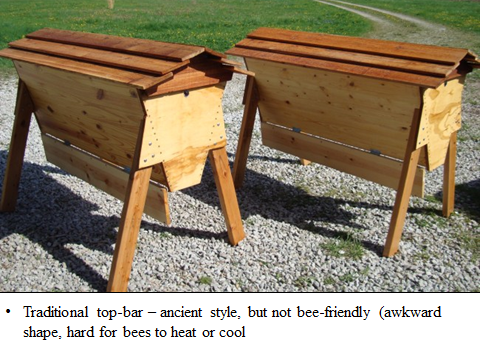 Top bar hives are oriented horizontally. Instead of holding full frames with foundation, like Langstroth
hives, they hold bars that rest along rails or dados along the inner top edge of the
hive body. Bees draw comb down from the top bars. At honey harvest, the beeswax
comb is harvested as well (it can’t be reused, as it can with Langstroth hives).
Top bar hives are oriented horizontally. Instead of holding full frames with foundation, like Langstroth
hives, they hold bars that rest along rails or dados along the inner top edge of the
hive body. Bees draw comb down from the top bars. At honey harvest, the beeswax
comb is harvested as well (it can’t be reused, as it can with Langstroth hives).
Image: http://beetherapy.org/blog/warre-langstroth-or-top-bar-which-hive-to-choose
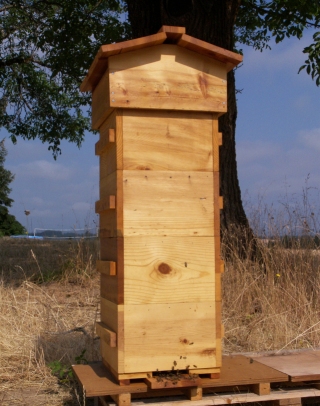 Warré hives are vertically stacked, like Langstroth hives. The uppermost box contains insulation
(such as wool, foam, polyfill, or leaves). The remaining boxes contain top bars,
as in the top bar hives.
Warré hives are vertically stacked, like Langstroth hives. The uppermost box contains insulation
(such as wool, foam, polyfill, or leaves). The remaining boxes contain top bars,
as in the top bar hives.
Image: http://thebeespace.net/warre-hive
